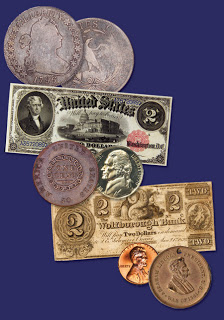
In the late 1850s the hobby of coin collecting became wildly popular. This time line from Dave Bowers’ popular book, The Expert’s Guide to Collecting and Investing in Rare Coins, sets the scene for all of the activity:
The Year 1859
The Mint as a Coin Dealer
The Mint became America’s largest ‘coin dealer,’ de facto, but not officially. From 1859 until about 1885, tens of thousands of rare patterns, restrikes, and other delicacies were made for the private profit of officials holding positions there. Years later, in 1887, when a new Mint director sought to learn details he was amazed to find that the only records on hand were for a few 1868 Proof sets struck in aluminum. Everything else was ‘off the books.’ Today, collectors are grateful for this secret activity within the Mint walls, as otherwise most Gobrecht silver dollars of 1838 and 1839, Flying Eagle cents of 1856, and pattern coins would not exist!
Director Snowden Seeks Washington Pieces
In early 1859, Director James Ross Snowden at the Mint was besieged with requests for pattern coins, Proofs, and rarities. These were supplied to the extent that examples were on hand, after which, beginning that spring, Snowden had some old dies dusted off and commenced to make restrikes of silver Gobrecht dollars of 1836-1839, the 1804 dollar, and other rarities.
Snowden himself was a numismatist, and his prime interest was to secure tokens and medals of George Washington to display in the Mint Collection. Word quickly spread that anyone having such pieces could trade them at the Mint for all sorts of valuable restrikes and rarities! The pattern 1856 Flying Eagle cent became a stock-in-trade item for insiders at the Mint, as such coins readily sold for $1 or more on the market. Newly created rare and valuable patterns, restrikes, and other delicacies were fed into the market and were eagerly purchased. There was little differentiation among collectors and dealers as to what was an original and what was a restrike. Each served equally well to fill a space in a collection and, if anything, restrikes were in higher grades and more attractive. While a later generation of numismatists would separate original and restrike half cents of the 1840s by the size of the berries in the reverse wreath, or realize that nearly all Proof 1856 Flying Eagle cents were restrikes and that absolutely all 1853 Proof dollars were likewise, no one cared back then.
And More!
Coin auctions became more frequent, and in 1859 dealer Sage catalogued four sales in New York City, more than any other professional. In Philadelphia, Edward Cogan and William K. Idler became important in the coin trade. Henry Cook bought and sold coins in Boston, another shop was open in Baltimore and a few more were scattered here and there. The first really large and impressive book for coin collectors was published, the American Numismatical Manual, by Dr. Montroville W. Dickeson.





